The Economics and Statistics Division maintains archives of previous publications for accountability purposes, but makes no updates to keep these documents current with the latest data revisions from Statistics Canada. As a result, information in older documents may not be accurate. Please exercise caution when referring to older documents. For the latest information and historical data, please contact the individual listed to the right.
<--- Return to Archive
For additional information relating to this article, please contact:
March 01, 2022CANADA GDP BY INDUSTRY, DECEMBER AND ANNUAL 2021 With December reference month results, year-over-year (December 2021 vs December 2020) and annual (2021 vs. 2020) are showing the rebounds in economic activity from the unprecedented declines observed at the start of the COVID-19 pandemic.
Real Gross Domestic Product (GDP) in Canada remained stable at an annualized value of $2,017 billion (chained 2012 dollars) in December 2021. In December, activity was up in 14 of 20 industrial sectors compared to the previous month, with gains in services producing (+0.1%) offset by a decline in goods-producing industries (-0.1%).
The Canadian economy was 0.4% bigger when compared to pre-pandemic February 2020 with an annualized value of $2,017 billion (chained 2012 dollars) in December 2021.
Statistics Canada’s preliminary estimate for real GDP shows 0.2% gain in January 2022. Gains in retail, construction, finance and insurance, and professional, scientific and technical services sectors were offset by declines in manufacturing, mining, quarrying, and oil and gas extraction, high contact services, and air transportation services sectors. The official GDP data for January 2022 will be published on March 31, 2022.
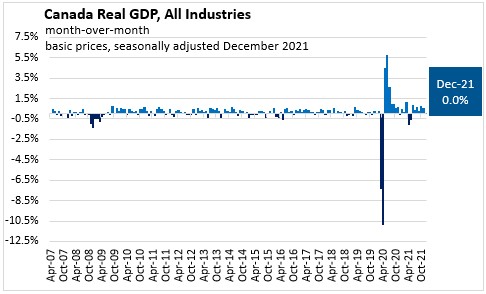
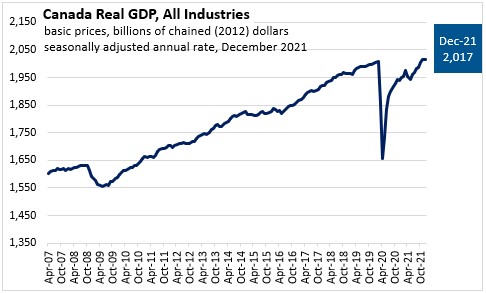
Goods-Producing Industries
Goods-producing sector output declined 0.1% month-over-month in December 2021.
Construction was down 0.6% as most sub-sectors saw decreased activity in December. Residential building construction decreased 2.5% led by lower home alterations and improvements partially offset by increases in apartment-type dwellings construction and single-family homes. Non-residential building construction was down 0.1% which was the first decline in six months. Repair construction declined 1.6%. Engineering and other construction activities increased 2.1% in December, posting the seventh consecutive monthly gain.
Mining, quarrying, and oil and gas extraction declined 2.2% in December as all subsectors contracted. Oil and gas extraction decreased 1.9% in December as production disruptions were further exacerbated by extreme cold in Western Canada. Mining and quarrying (except oil and gas) was down 3.8%. Coal mining was down 11.0% following 18.3% decline in November due to continued exports disruptions caused by flooding in British Columbia. Metal ore mining declined 3.2% led by decline in iron ore mining and copper, nickel, lead and zinc ore mining due to a slow down in international demand for the commodities. Support activities for mining, and oil and gas extraction were down 0.5% in December, after seven consecutive months of growth.
Manufacturing activity increased 0.5% in December, led by growth in non-durable goods. Non-durable goods manufacturing activity increased 1.0% driven by a 6.1% gain in plastics and rubber products and 2.5% gain in chemical manufacturing partially offset by declines in beverage and tobacco (-4.6%) and food manufacturing (-0.4%). Durable-goods manufacturing was unchanged with higher activity in fabricated metal products, non-metallic mineral products, and transportation equipment were offset by declines in miscellaneous, machinery and computer and electronic product manufacturing.
Utilities increased 1.4% in December on higher electric power generation, transmission and distribution and natural gas distribution. Heating demand in Western Canada increased due to low seasonal temperatures.
Services-Producing Industries
Output of the services-producing sector increased 0.1% in December 2021.
Wholesale trade rose 0.9% in December posting the fifth consecutive monthly increase, led by growth in motor vehicle and motor vehicle parts and accessories.
Transportation and warehousing services increased 0.6% in December with 7 of 10 subsectors posting gains. Air transportation (+10.9%) led the growth on higher international movements of passengers and goods.
Retail trade was down 2.7% with 11 of 12 subsectors posting declines, led by declines in the stores associated with holiday shopping (clothing and clothing accessories stores, general merchandise, and food and beverage stores). Retail trade declined in December due to supply chain disruptions and reintroduction of restrictions related to Omicron variant before the busiest holiday-shopping period. Building material and garden equipment and supplies declined the first time in five months.
Accommodation and food services sectors decreased 1.5% in December due to lower activity in food services and drinking places. Accommodation services increased 0.9% in December posting the seventh consecutive monthly increase while the rate of growth decelerated at the end of 2021.
Arts, entertainment and recreation sector decreased 3.7% in December with decline in both subsectors. Performing arts, sports and heritage institutions (-5.7%) led the decline driven by the reintroduction of capacity limits and other indoor restrictions and postponement or temporary pause of professional sports leagues in Canada. Amusement, gambling and recreation industries declined 2.3%.
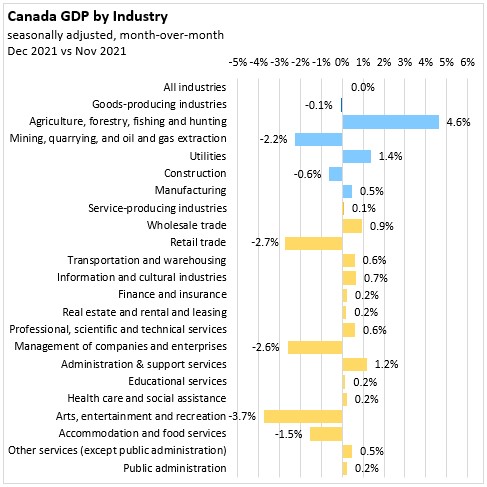
December 2021 vs February 2020
Canadian real GDP was 0.4% higher when compared to February 2020.
Amid the COVID-19 pandemic and recovery to date, the service sectors with the current largest declines in activity are in management of companies and enterprises (-48.1%), arts, entertainment and recreation (-25.0%), transportation and warehousing (-13.2%) and accommodation and food services (-12.8%). For December 2021, all goods-producing industries were at lower levels of activity than February 2020 except mining, quarrying, and oil and gas extraction. Activity has increased the most in finance and insurance (+7.2%), professional, scientific and technical services (+4.8%), real estate and rental and leasing (+4.1%), and health care and social assistance (+3.7%).
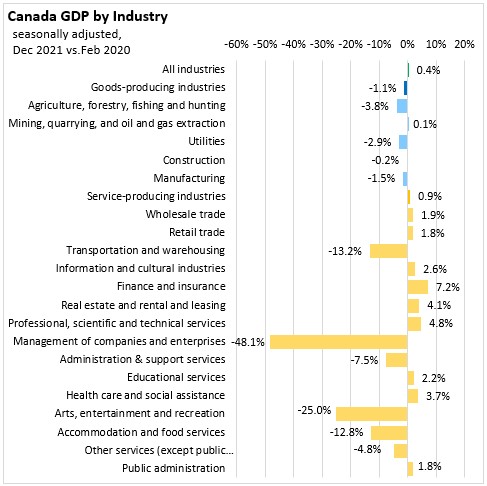
Annual (2021 vs 2020)
The Canadian economy in the 2021 increased 4.9% compared to 2020.
Compared to 2020, the largest increases in activity have been in accommodation and food services (+14.2%), health care and social assistance (+9.0%), mining, quarrying, and oil and gas extraction (+8.9%), other services (except public administration) (+7.7%) and retail trade (+7.1%). Activity decreased the most in management of companies (-26.4%) and agriculture, forestry, fishing and hunting (-8.1%).
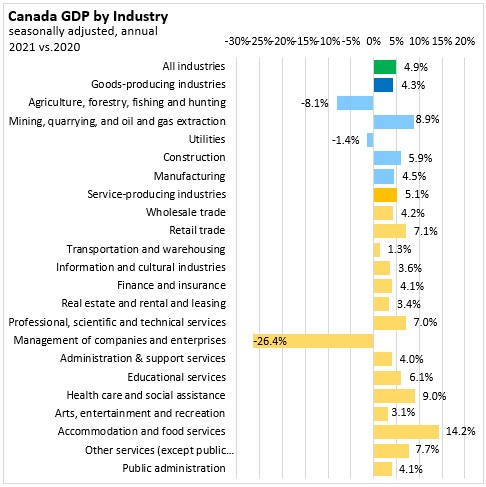
Source: Statistics Canada, Table 36-10-0434-01 Gross domestic product (GDP) at basic prices, by industry, monthly (x 1,000,000)
<--- Return to Archive